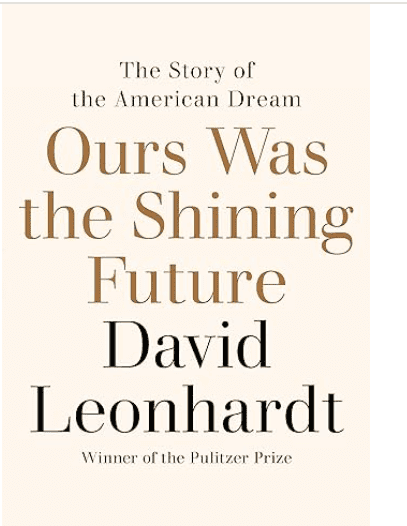
By Jim Heffernan
I was attracted to this book because of the author and the topic. David Leonhardt is a Pulitzer Prize winning columnist for the New York Times I’ve read for years and the question of what has become of the “American Dream” is an obsession of mine.
The book examines the linkage of economics and history of the America, concentrating on the last 100 years. It’s a very apt period to study because it encompasses the vast pendulum swing that economic inequality has taken.
The book is divided into two large sections, “The Rise” and “The Fall” describing the relative economic equality of the “working class” American. He describes the rise and fall in terms of power, culture, and investment.
I think the best feature is the story telling. Each topic begins with a profile of a person closely connected to the topic, some are famous and some are obscure. But the story is always skillfully put forward.
“Rough and tumble” capitalism brought the nation to a high level of prosperity by the 1920’s. But by its very nature, prosperity was not evenly shared. The 1920’s were called the “Gilded Age” because the gulf between rich and poor was at its highest point until recent days. Accordingly, power was highly concentrated in the wealthy class and investment for the common good was at a minimum.
The crash of 1929 and the election of Franklin Delano Roosevelt (FDR) ushered in an era of “democratic capitalism” where power began to shift to the working class and widespread investment in infrastructure and the establishment of Social Security promoted the common good of all. “Democratic capitalism” supplanted “rough and tumble” capitalism.
While the stock market crash wiped out a potion on large fortunes, the rise of unions and FDR’s new policies elevated the fortunes of the working class.
A surprising amount of the progress can be attributed to the dynamic partnership between FDR and Francis Perkins, the first woman cabinet minister and Secretary of Labor from 1933-1945. Social Security was largely her invention. I truly believe Francis Perkins deserves more fame than she has.
FDR’s policies largely persisted until about 1980 and the period of time between 1930 and 1980 is referred to as the “Great Compression” where the gap between the rich and poor continuously shrank. This period of time is dealt with in “The Rise” portion of the book.
“The Fall” portion of the book deals with the years from around 1980 onwards when the “Great Divergence” reversed the trend for greater income equality. Once again, he examines the trend in terms of power, culture, and investment. The main driver of the shift was “movement conservatism” that percolated in the 1970’s and hit its full stride with the election of Ronald Regan in 1980. Power was shifted to big business, we became enamored with the idea shrinking the government, and any investment in projects for the common good evaporated.
He is very even-handed in apportioning blame. Both Republicans and Democrats seem to be too attached to their primary sources of money. I particularly enjoined him talking about “the brahmin left” where the Democratic party sort of splintered and became dominated by college educated people. In effect, they abandoned the working class.
I lived through the years Leonardt writes about and I am hard-put to find a place where he puts a foot wrong. I hope his hopes for a new progressive movement reduce inequality come to pass.
Available at Cloud and Leaf Bookstore, Manzanita
515 pages, (168 pages acknowledgment, notes and index)
Published October 24, 2023


